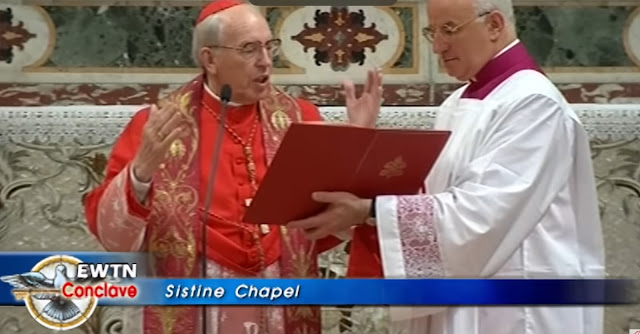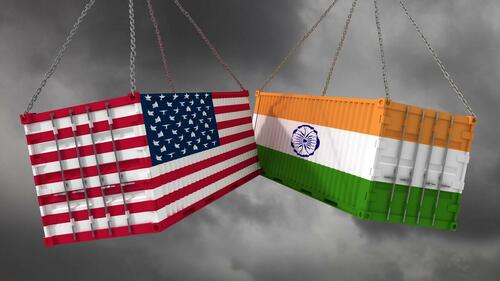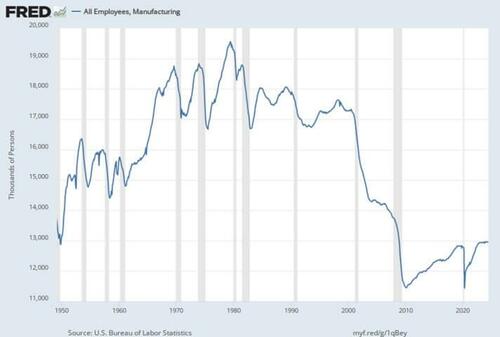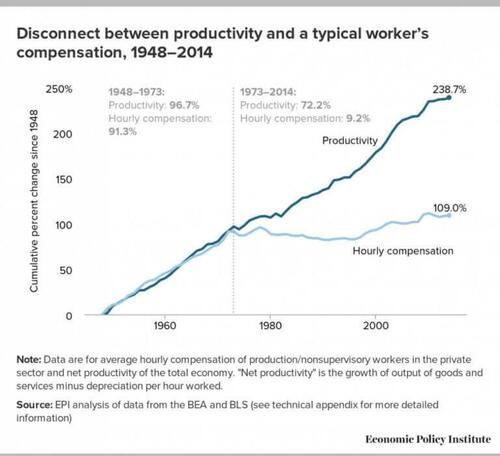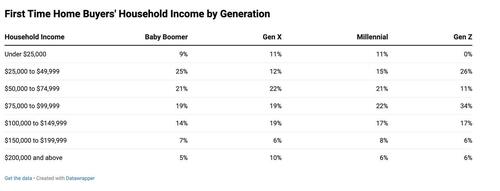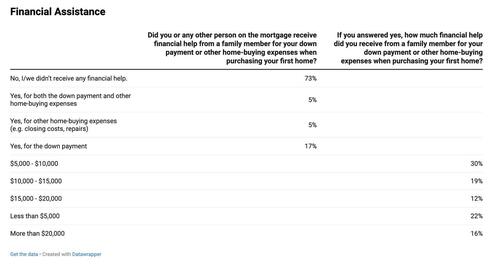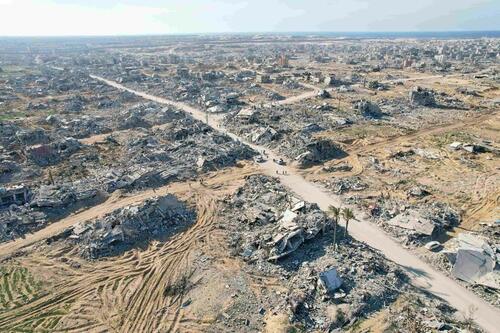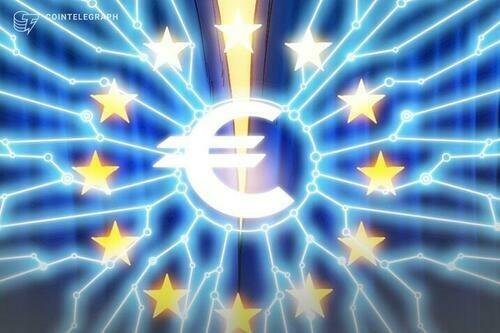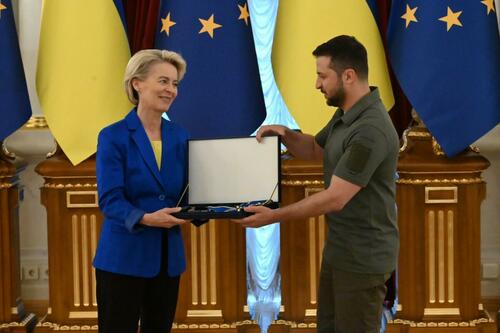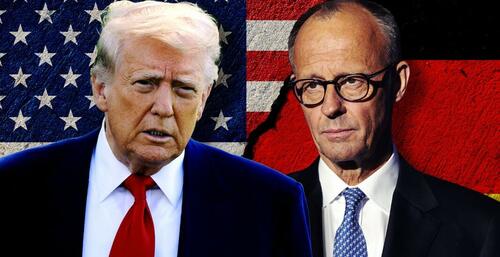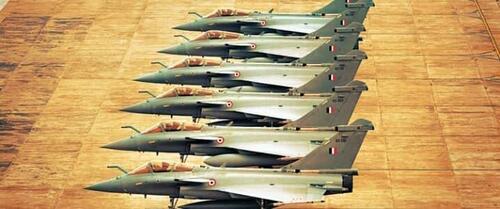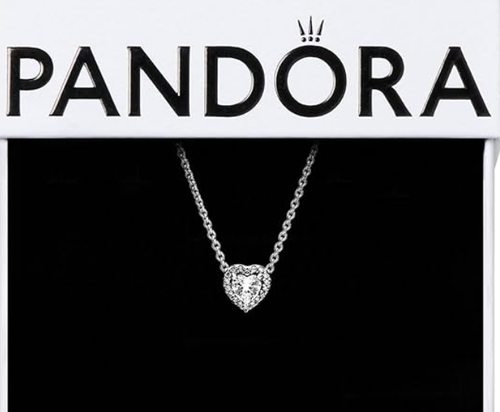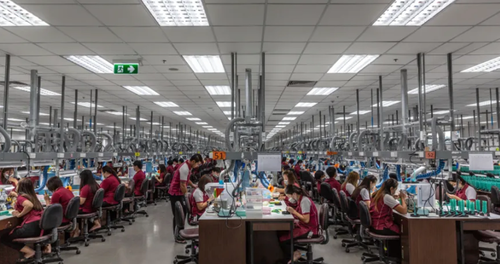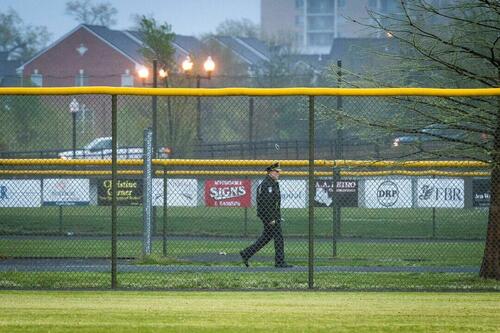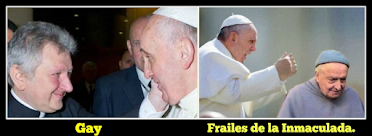It is sad that there are what you might call professional Catholics who make a living on their Catholicism, but in whom the spring of faith flows only faintly, in a few scattered drops. We must really make an effort to change this.
Distinction Matter - Subscribed Feeds
-
Site: Mises InstituteIn the name of fighting income inequality, pundits in the UK and US are calling for wealth taxes as magic bullets that will restore an imaginary state of income equality that never existed in the first place. It is time to abandon this idea for good.
-
Site: Mises InstituteThe bottom 80% of America is in recession and is starting to cut back on extra spending such as fast food.
-
Site: Novus Motus LiturgicusThe church of Milan today celebrates the feast of the martyr St Victor, a Christian soldier from the Roman province of Africa, who was killed in the first year of the persecution of Diocletian, 303 AD, while serving at Milan under the Emperor Maximian. He is usually called “Maurus - the Moor” to distinguish him from the innumerable other Saints called Victor, which was a very common name in the Gregory DiPippohttp://www.blogger.com/profile/13295638279418781125noreply@blogger.com0
-
Site: Catholic ConclaveWhat made Tagle such a popular figure are also some clips that have become “memes” on the web“Our favorite is him, the Asian Francis”: the social media cheering for Cardinal Tagle. Here’s why he’s Gen Z’s favorite at the ConclaveSmartphones in the air and a shower of memes have made the conclave more social than ever. The election of the new Pope began on Wednesday, May 7, and St. Peter’s Square Catholic Conclavehttp://www.blogger.com/profile/06227218883606585321noreply@blogger.com0
-
Site: southern orders
Interestingly enough, Cardinal Re who was the celebrant for the pre-Conclave Mass at St. Peter’s (he is 93 I think) was the Dean of the Cardinals for the Conclave in 2013 which elected Cardinal Bergoglio.Cardinal Parolin, now the Dean of Cardinals led the Conclave in 2025 (yesterday).
At the 2013 Conclave there were many more cardinals who wore lace surplices than at the 2025 Conclave, although lace was certainly to be found on cardinals, some quite young.
Please note the ornate stole and lace surplice that Re wore in 2013 compared to what Cardinal Parolin wore yesterday in 2025.
-
Site: RT - News
The two countries bear a “special responsibility” before the international community, the Chinese president has said
Beijing and Moscow have a duty to oppose unilateralism and coercion on the world stage, Chinese President Xi Jinping has said during a meeting with his Russian counterpart Vladimir Putin.
Xi has arrived in Moscow to take part in festivities dedicated to the 80th anniversary of the Soviet victory over Nazi Germany on May 9.Before the start of the talks on Thursday, Xi praised close bilateral relations, stating that “China is ready to jointly bear a special responsibility with Russia, as major world powers and permanent members of the UN Security Council, to courageously defend the truth about the history of World War II” in the face of what he called “negative trends of unilateral actions and power-based coercion in the world.”
The Chinese leader also noted that under his and Putin’s “strategic guidance,” the relations between the two countries had entered a new era. “Our political interaction is strengthening, practical cooperation is deepening, and cultural, humanitarian, exchange, and interregional ties are gaining momentum,” he said.
Read more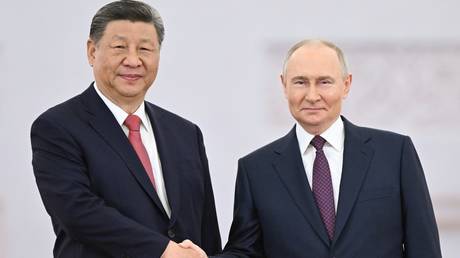 Russia and China will never forget WWII victims – Putin
Russia and China will never forget WWII victims – Putin
Meanwhile, Putin noted that the cooperation between the two nations is not directed against any third party. “We are developing our ties for the benefit of both peoples and not against anyone. Our relations are equal, mutually beneficial, and not opportunistic. The intention to build good-neighborliness, strengthen friendship, and expand cooperation is a strategic choice made by Russia and China,” he said.
Russia and China have enjoyed close ties for decades, with the two nations affirming a “no-limits” partnership in 2022. Moscow and Beijing have also increasingly shifted away from reliance on the US dollar, with both countries expanding trade in their national currencies. According to Russian officials, the share of bilateral transactions conducted in rubles and yuan now exceeds 95%.
-
Site: Fr. Z's BlogCollectively we can do some looking around. If you are watching online or by TV any coverage of the conclave, or the chimney, what service or network are you watching? Also, WHOM have these services or networks brought in for … Read More →
-
Site: Zero HedgeIndia Is China 2.0Tyler Durden Thu, 05/08/2025 - 06:30
Authored by Spencer Morrison via American Greatness,
India is taking President Trump up on his offer for reciprocal free trade, proposing zero-for-zero tariffs on specific goods like pharmaceuticals, steel, and automobile components.
This has electrified President Trump’s base—the reciprocal tariffs are working! India’s coming to the table!
Sorry to burst your bubble: America will not benefit from free trade with India—or any other Third World country.
Why?
One word:
Externalities.
President Trump would be wise to remember that tariffs are not about moving factories from China to India—they’re about moving factories back to America.
Hunting Unicorns
Real international free trade—much like real communism—has never been tried. Why? It’s impossible.
The reality that economists & libertarians refuse to recognize is that different countries are different. And not just different in a nominal sense—different in real and practical ways that prevent economic integration.
First, America and India have different levels of economic development that cannot be reconciled without seriously rebalancing the factors of production.
The average annual wage in America is $63,000, while the average annual wage in India is just $2,500—the average American earns 25x more than the average Indian. Labor is often the largest input cost for making products, accounting for approximately 30–35% of the cost of American manufacturing—and it’s an even higher proportion in many service industries.
If America and India traded freely, India’s low wages would undercut America’s labor market—either Americans will need to accept lower wages domestically, or the factories will relocate to India to take advantage of dirt-cheap labor.
How do we know this will happen? The exact same thing happened after China joined the World Trade Organization (WTO) in 2001.
In 2001, the average annual wage in America was $30,846, while the average annual wage in China was just $1,127—the average American earned 27x more than the average Chinese. What happened when American workers competed with Chinese workers? American factories moved to China, and wages stagnated.
The pace of offshoring was harrowing. Since 2001, more than 60,000 factories have moved abroad, killing over 5 million manufacturing jobs. This has decimated America’s industrial capacity and hollowed out local communities. And no, robots and automation had nothing to do with this process, in case you were curious.
In fact, the process has been going on even earlier than 2001. America has run global trade deficits every year since 1974. The cumulative value of these deficits is $25 trillion, after adjusting for inflation. This has decoupled wages for American workers from their productivity—even though workers produce more value, they aren’t paid for it. Why? Because the wages are suppressed by competition with cheap foreign labor.
Notice how the price differentials respecting America and China in 2001 and America and India today are almost identical. Why do we think the result will be different this time around?
From India With Love
In addition to obvious market asymmetries like the price of labor, the cost of doing business in India is lower because of externalities. Essentially, there are many costs of doing business in America that are baked into the final price of a product, such as the costs of environmental remediation, labor standards, and upholding higher quality control standards.
These costs are not baked into the price of Indian products. Instead, the costs of pollution or abusive labor standards are externalized to the environment or society at large.
But of course, we always pay the piper. Rather than pay 10 cents more per spatula, we live with plastic trash from India floating up on American beaches or mercury poisoning the fish we eat—we may not pay the price at the store, but we certainly pay it with our health and with our soul—all for the sake of “cheap” goods.
Often, foreign goods are not actually cheaper than American goods: they simply do not reflect the full cost of production. For this reason, America cannot produce goods as cheaply as China or India—not unless we are willing to destroy our standard of living—not unless we are willing to sacrifice our environment—not unless we are willing to outlaw morality in the name of business and sell our very soul for profit.
No. Reducing the cost of business to compete with India on price is simply not desirable. Nor is it possible.
Remember, even if America allowed manufacturers to externalize all costs, our economy is structurally distinct from India’s. In America, private corporations dominate the market. Although these corporations are large, and many are owned by the same few investment firms—like BlackRock—they remain private entities.
This is not the case in India, where the state is crafting a cohesive industrial policy designed to industrialize the country. Part of this policy appears to be to piggyback on America’s consumer market when it comes to strategic industries, like steel or pharmaceuticals—just like China.
Ultimately, the only way to protect America’s market from asymmetrical competition from countries like China or India is to price in these externalities by imposing protective tariffs. This is discussed in detail in my book Reshore: How Tariffs Will Bring Our Jobs Home & Revive the American Dream.
The Shock and Awe of Reality
Different countries have different levels of economic development, legal systems, tax structures, histories, geographies, languages, cultural and business norms, and demographics. All of these differences can create market asymmetries that are simply not relevant domestically.
At best, free traders can reduce tariffs and other visible trade barriers, like taxes, transportation costs, and legal disharmonies. However, they cannot uproot the sort of cultural norms and political corruption that make doing business in India—or China, or Mexico, or Italy—different than doing business in America.
Ultimately, America’s interests are not served by moving industry from China to India. The industry needs to come home. Let’s not make the same mistake with India that we did with China—say no to free trade and raise the tariff walls.
-
Site: Catholic Herald
The signal of black smoke – fumata nera – indicating that the 133 cardinal-electors have failed to elect a new pope has come from the Sistine Chapel chimney following the first two ballots of the day.
Black smoke billowing from the chimney at 11.51 a.m. local time in Rome indicated that again the required two-thirds majority hasn’t been achieved to find a successor to Pope Francis, who died on Easter Monday, 21 April, at the age of 88 years old.
Once white smoke emerges that will be the signal that the next leader of the world’s 1.4 billion Catholics and the 267th pope has been chosen.
The following voting and ballot burning times are given as rough estimates for Thursday 8 May and Friday 9 May:
First ballot
Rome — 10:30
London — 09:30Second ballot
Rome — 12:00
London — 11:00Third ballot
Rome — 17:30
London — 16:30
Fourth ballot
Rome — 19:30
London — 18:30Smoke will only appear after the first and third ballots if a pope has been elected. Otherwise, after every two rounds, the cardinals’ ballot papers, on which they write the name of the person they want elected pope, are burned in one of two special stoves installed inside the Sistine Chapel for the conclave, with black smoke emitting after the second and fourth ballots.
It means that as far as today is concerned, we will only see smoke (white) after the third ballot at 5.30 p.m., local time Rome, if a pope is elected; otherwise, there will be no more smoke today until after the fourth ballot at 7.30 p.m., when either black or white smoke will be released.
RELATED: Ballot burning times: when to watch for white smoke
Photo: Black smoke rising from the chimney of the Sistine Chapel signalling that cardinals failed to elect a new pope during their conclave, Vatican, 8 May 2025. (Photo by TIZIANA FABI/AFP via Getty Images.)

The post ‘Fumata nera’ again from conclave chimney first appeared on Catholic Herald.
The post ‘Fumata nera’ again from conclave chimney appeared first on Catholic Herald.
-
Site: Catholic Herald
The menu for the cardinal-electors involved in the conclave to elect the next pope has been designed by a nutritionist to assist participants in their arduous task and to offset the likes of increased stress levels.
Nutritionist Giorgio Calabrese, an Italian doctor who specialises in nutritional science, is behind the special conclave menu comprising dishes designed specifically to provide the necessary energy for the cardinals as they lead a sedentary but stressful life for several days, reports the Catholic News Agency (CNA).
“Since they won’t be moving around much and have little time because they have four votes a day, I proposed a menu tailored to this circumstance,” says Calabrese, who is also the scientific adviser to the Italian Ministry of Health. He explains that because the cardinals “need to be focused” this raises the level of cortisol, the so-called “stress hormone” produced in their bodies “through the adrenal glands”.
This can be compounded, he says, for those cardinals from Northern European or American cultures, where savory breakfasts are more common, thereby “overloading their metabolic system just when they need immediate energy” that is better provided by “simple carbohydrates”.
So to help lower cortisol levels, “it makes more sense for them not to have bacon, eggs and meat for breakfast but rather a sweet breakfast, with partially skimmed milk and toast with jam or honey”.
Needless to say, they will also be offered tea or coffee: “This is essential because in the morning they have to deal with the stress of voting,” Calabrese said.
Lunch, the nutritionist explained, should be light, quick and tasty, “satisfying the palate without overloading” the body.
The menu offers this with the likes of a first course such as light pasta with tomato and fresh basil, or a vegetable or legume risotto, “for good digestion and a dose of carbohydrates that provide energy”.
For the main course, it could be “white meat or grilled, not fried, fish with steamed or grilled vegetables”.
He also highlighted the importance of using “extra virgin” olive oil and toasting the bread to avoid excessive crumbs, as they contain a lot of fat. On the other hand, he noted that the crust “contains carbohydrates rich in fiber” that are good for maintaining health.
“Since they will continue in the afternoon with two more votes, they may take a short nap,” he explained. In order not to unduly impact this, for dessert, the nutritionist recommends a piece of fruit.
“If they were outside, I would tell them to have ice cream. But since they can’t be, the nuns can give them fresh fruit, like strawberries, blueberries, and raspberries,” Calabrese said.
He also recommended having “partially skimmed yogurt” mid-afternoon. “They can also have tea, but one with less caffeine, to avoid agitation.”
By evening, having already gone through four votes, “They’re stressed, so they can’t eat pasta carbonara or amatriciana.”
Instead, dinner should be “easy to digest”. Therefore, the proposed menu includes “cooked ham, smoked salmon, bluefish or sardines, tuna without added oil or sauce and bresaola”.
“All of this can be alternated with fresh cheeses, such as mozzarella,” he added.
Wine is available, though Calabrese emphasised that if wine is desired it should be drunk in moderation, and, ideally, “only a glass”.
Stronger alcohol, such as liquor, “puts a heavy strain on the liver, and that takes energy away from the brain” (though the CNA report didn’t clarify if hard liquor is actually off the menu).
He added: “They need to keep their minds active and not overtax their liver. That’s why a glass of wine is enough. You drink water to hydrate, you savor wine to nourish yourself.”
As an alternative to wine, the nutritionist suggested a Moscato d’Asti, which is “pleasant and low in calories and alcohol [5 per cent].”
Since there are 133 cardinals, Calabrese acknowledges the likelihood that someone has an intolerance or allergy.
Giving the example of someone who has celiac (a long-term autoimmune disorder, primarily affecting the small intestine), “they can use gluten-free pasta, or rice, which is gluten-free. Also, oats, corn, and quinoa can be substituted.”
If someone is lactose intolerant, “instead of milk or yogurt, they can have tea or coffee” to give them a boost.
Calabrese noted that while the menu was submitted to the Vatican, ultimately the final decision is made by the nuns who run St. Martha’s House – where the cardinals are accommodated – the Daughters of Charity of St. Vincent de Paul.
There are also “trusted” laypeople in charge of serving the cardinals as well as several cooks, all of whom were sworn to secrecy on Monday, as were other personnel involved, such as transportation staff, reports CNA.
The chef in charge of the kitchens is also subject to strict secrecy. Therefore, the exact menu reserved for the cardinals during the conclave is unknown.
All meals must be prepared exclusively at St. Martha’s House, as bringing in food prepared outside the Vatican kitchens is strictly prohibited.
Photo: The flag of Vatican City is seen on St Peter’s Square on the second day of the conclave, in the Vatican on May 8, 2025. (Photo by Stefano Rellandini / AFP)

The post Cardinals on a diet of discernment: Vatican nutritionist designs stress-friendly menu for conclave first appeared on Catholic Herald.
The post Cardinals on a diet of discernment: Vatican nutritionist designs stress-friendly menu for conclave appeared first on Catholic Herald.
-
Site: AsiaNews.itIn the era of tariffs, stimulating domestic demand is vital for Beijing. But consumption is growing slowly—and it is no longer the megacities driving it, but smaller cities, where wages and confidence in the economy are rising. These shifts may also bring about broader social changes.
-
Site: AsiaNews.itBehind the demonstrations is the mysterious fall of a young woman from a building in the capital. According to some sources, politicians and prominent figures are involved. The incident allegedly took place during a party with drugs and alcohol in the Muslim-majority nation, and the police are accused of covering it up. Close associates of the president are also under scrutiny.
-
Site: Catholic ConclaveThe General Congregations preceding the conclave are displaying a new tone, different from that of twelve years ago. In 2013, the cardinals elected Jorge Mario Bergoglio after a brief, direct, and well-structured speech that captured the audience and became the catalyst for his election. The famous anecdote of the "outgoing Church" spread around the world and, almost immediately, consolidated Catholic Conclavehttp://www.blogger.com/profile/06227218883606585321noreply@blogger.com0
-
Site: Catholic Herald
Fittingly for what some are calling the first “clickbait conclave”, the Vatican is providing a live footage feed of St Peter’s Square.
It means that wherever you are in the world, despite the 133 cardinal-electors being sealed off from the world in the Sistine Chapel, you can follow the ballots of their votes by watching for smoke coming from the chimney on top of the famous chapel – which sits to the right of St Peter’s Basilica as you look at the front of the basilica – that signals whether a new pope has been elected.
The signal of black smoke – fumata nera – serves to show that the cardinal-electors have failed to elect a new pope in the latest ballot of the conclave.
Black smoke billowing from the chimney indicates that no decision has been reached and that the required two-thirds majority hasn’t been achieved to find a successor to Pope Francis, who died on Easter Monday, 21 April, at the age of 88 years old.
Once white smoke emerges that will be the signal that the next leader of the world’s 1.4 billion Catholics and the 267th pope has been chosen.
The following ballot burning times are given as rough estimates for Thursday 8 May and Friday 9 May:
First ballot
Rome — 10:30
London — 09:30Second ballot
Rome — 12:00
London — 11:00Third ballot
Rome — 17:30
London — 16:30
Fourth ballot
Rome — 19:30
London — 18:30Smoke will only appear after the first and third ballots if a pope has been elected. Otherwise, after every two rounds, the cardinals’ ballot papers, on which they write the name of the person they want elected pope, are burned in one of two special stoves installed inside the Sistine Chapel for the conclave, with black smoke emitting after the second and fourth ballots.
Saturday 10 May 2025
If no candidate has been elected, then this day will be set aside for prayer and reflection. The last time a conclave lasted more than three days was 1958, when John XXIII was elected on the fourth day of the conclave, though there had been no ballot on the first day. The other outlier during the 20th century was the election of Pius XI in 1922, which took five days, though there was again no ballot on the first day.
Sunday 11 May – Tuesday 13 May
Following a day of prayer and reflection, the 133 cardinals will vote in seven more ballots following the same rough schedule given above, after which, if there is still no successful candidate, the conclave will break for another day of prayer and reflection.
Wednesday 14 May onwards
The cardinals will vote in up to 18 more ballots, again following the same rough schedule given above, until a candidate receives two-thirds of all votes cast. If there is still no winner, a run-off between the two top candidates will be held until one of them receives the required majority.
RELATED: Taking charge of 1.4 billion souls: the spectacle gripping the world
Photo: People gather in St. Peter’s Square during the first day of conclave, Vatican, 7 May 2025. (Photo by Marco Di Lauro/Getty Images.)

The post LIVE FOOTAGE: White Smoke Watch first appeared on Catholic Herald.
The post LIVE FOOTAGE: White Smoke Watch appeared first on Catholic Herald.
-
Site: Zero HedgeFirst-Time Homebuyers Face Shifting Market, Stress, Struggles: New SurveyTyler Durden Thu, 05/08/2025 - 05:45
A new survey of 1,000 first-time homebuyers reveals the complex and often stressful reality of entering the housing market. Rising housing prices, high interest rates, and market uncertainty have created a tough environment for newcomers, many of whom must stretch their budgets or make lifestyle compromises just to get a foot in the door, according to a new survey from Raleigh Realty.
The survey shows a clear generational divide in homeownership. The majority of first-time buyers are Gen X or Baby Boomers, while only 4% are Gen Z. For younger adults, especially Gen Z, the barriers to entry remain high. Those who do purchase tend to be higher earners—63% of Gen Z buyers make more than $75,000 annually. In contrast, many Baby Boomers bought their first homes with more modest incomes, suggesting that affordability has deteriorated over time.
Income still plays a central role in homeownership access. While many first-time buyers earn between $50,000 and $75,000, a significant portion earn less, especially among older generations. Gen Z stands out again here, with relatively few buyers earning below $50,000. This trend reflects broader concerns among younger people about financial stability, shaped by growing up during the 2008 housing crash and entering adulthood amid pandemic-era economic turmoil.
Flexible work has had a strong impact on home buying decisions. A third of first-time buyers work remotely or in hybrid roles, and this flexibility often enables them to relocate in search of more affordable housing or better quality of life. Gen Z leads in remote work adoption, with more than 40% working fully in-office, while Baby Boomers represent the largest group not in traditional employment, instead relying on retirement income or alternative sources.
Despite media narratives about falling housing prices, very few first-time buyers made purchases in the last year. Most bought their homes three to four years ago, during or shortly after the pandemic housing surge. The steep drop in 2023 home sales reflects wider economic conditions, including high inflation and reduced affordability.
Single-family homes remain the overwhelming favorite among first-time buyers, with 90% choosing this option regardless of income. Even those earning less than $50,000 opted for standalone houses over condos or multi-family units. However, most chose existing homes rather than new construction, likely due to cost or availability.
For many, the journey into homeownership was taken solo or as a couple. Half of respondents were married, while 40% were single. Only a small percentage bought homes with friends, siblings, or unmarried partners. These results reflect traditional patterns of household formation and financial independence.
Most buyers moved quickly once they started looking for a home. About 70% closed within six months, and 35% found a home in three months or less. But speed didn’t reduce stress—90% of first-time buyers found the process difficult. The top source of stress was affordability, which overwhelmed concerns about mortgage approval, taxes, or maintenance.
Financial strain led many buyers to make compromises. Nearly one in five settled for smaller homes, less desirable locations, or properties needing repairs. Stretching the budget was another common trade-off. Baby Boomers were most willing to go over budget, while Gen Z was most likely to compromise on location.
Concerns about job stability were widespread. More than half of buyers worried they wouldn't be able to make mortgage payments if they lost their job, with the highest anxiety levels among Gen Z and Millennials. Baby Boomers, by contrast, were more confident in their financial resilience, likely due to retirement savings or paid-off homes.
Contrary to popular belief, most first-time buyers didn’t receive financial help. About 73% paid for their homes without family assistance. Among those who did receive help, contributions varied, with 52% getting $10,000 or less. Just 16% received over $20,000, and only a small share received help from government programs.
The Raleigh Realty report says that even though mortgage approval is a common concern, most buyers didn’t apply for financing until after they began house hunting. Over half only applied to one lender. The majority selected lenders based on interest rates, while others went with banks they already used or those recommended by real estate agents.
Despite all these financial concerns, most buyers reported feeling satisfied after purchasing. While only 12% said they bought their dream home, 73% felt that homeownership brought them closer to the American dream. Lower-income buyers tended to report the highest satisfaction, possibly because expectations were more modest.
Few first-time buyers plan to move soon. Only 9% expect to sell their homes within five years, while nearly half intend to stay for at least a decade. A long-term mindset seems to dominate, with 30% planning to remain for 20 years or more.
Home improvement is a common post-purchase goal. Around 60% of buyers expect to invest $1,000 to $10,000 in upgrades during the first year, and nearly one in three plan to spend even more. These projects are seen as essential for adding value or addressing compromises made during the purchase process.
Younger buyers are also more likely to explore income-generating strategies. Around 40% of Gen Z and 30% of Millennials have taken on a second job to manage homeownership costs. Many also rent out parts of their property or use short-term rental platforms. In contrast, only 14% of Baby Boomers supplement their income in this way.
Emergency savings are more common among first-time buyers than the general population. Around 79% reported having some form of savings, with most holding over $1,000 and 17% saving more than $20,000. Younger buyers may be more motivated to save due to fears about job loss or economic instability.
In summary the full survey results show that while homeownership is still viewed as an important milestone, today’s first-time buyers are navigating a complex and stressful landscape. Income, generational experience, and work flexibility all influence outcomes, and most buyers are willing to make sacrifices to achieve the goal of owning a home.
-
Site: Catholic Herald
When people think of the papacy, they often envisage St Peter’s Basilica, the vast halls of the Vatican and centuries of European dominance in the Church’s highest office. Few, however, remember that the papacy did not begin in Rome – it began in Palestine.
The first Pope, St Peter, was a Palestinian Jew: a fisherman from Galilee who answered Christ’s call. His faith was shaped by the land where Jesus walked, where the Beatitudes were first spoken and where the Church itself took root. Yet today, as Christianity struggles to survive in its birthplace, the absence of a modern Palestinian or Middle Eastern Pope raises a question, rarely asked. Could it ever happen again? And if it did, and there was another Palestinian pope, what would it mean?
For centuries the papacy was almost exclusively European, distancing itself from the region where it all began. But history tells a different story – one that has been largely forgotten. At least two other popes, Evaristus and Theodore I, hailed from Palestine. Both led the Church through times of great turmoil.
St Evaristus, who was pope from AD 99 to 107, is traditionally believed to have been born in Bethlehem. He led the early Church during Roman persecution, providing spiritual guidance to Christians facing immense challenges. St Theodore, who reigned from AD 642 to 649, was born in Jerusalem. He defended the orthodox understanding of Christ’s dual nature against the Monothelite heresy, excommunicating those who promoted it.
By then Islamic conquests had already reshaped the Middle East; Jerusalem had been under Muslim rule since AD 638. Evaristus and Theodore were not just spiritual leaders; they were survivors shepherding a Church that was fragile, persecuted and deeply connected to its Palestinian and Eastern roots.
Today, Palestinian Christians, the direct heirs of this legacy, are barely visible on the world stage. Their numbers are shrinking, their voices drowned out, and their historical role in the Church is often ignored – or worse, deliberately silenced. I still remember the words of my aunt, spoken with quiet sorrow: “We are the people of the land where Christ was born, but it feels as if the Church has abandoned us. Do they not feel our suffering and pain? Do they not see the apartheid wall that cuts Bethlehem from Jerusalem? Do they not hear our prayers?”
Her words have stayed with me. While the Church calls itself universal, its leadership rarely reflects the land where its faith began. Gestures, while important, are not enough. Electing a pope from Palestine or the wider Middle East would be a historic correction – a declaration that Christianity is not merely a Western religion but one deeply rooted in its place of origin.
The idea of a modern Palestinian or Arab Pope might seem unlikely. The Vatican has long been shaped by European leadership, and there is only one cardinal of Palestinian descent – Fernando Natalio Chomalí Garib, the Archbishop of Santiago. But history has a way of surprising us. The Church has already broken traditions, choosing popes from Poland, Germany and Argentina. So why not from the land where Christ was born? Why not from the people who have safeguarded the faith through centuries of trials? Sometimes, the most unexpected choice is the one that speaks the deepest truth.
Figures like Cardinal Louis Raphael Sako of Iraq, Cardinal Béchara Boutros al-Rahi of Lebanon, or even Cardinal Pierbattista Pizzaballa, the Latin Patriarch of Jerusalem, represent a Church still deeply tied to its Eastern heritage. Though Pizzaballa is Italian by birth, he has dedicated his life to the Christians of Palestine – living among them, understanding their pain and struggles, and advocating for their aspirations. Could the Church look toward its own cradle for leadership?
A young Palestinian seminarian once told me: “We remain faithful, trusting in the Lord’s promise that the gates of hell shall not prevail against His Church. We endure, carrying our crosses as Christ carried His. But sometimes, we wonder – does the universal Church remember us, her children in the land where salvation history unfolded? Or have we become mere relics of the past, or worse, stones in ancient churches that pilgrims visit to renew their faith, while our living faith goes unseen?”
His words echo a painful truth. Palestinian and Middle Eastern Christians exist, but they are often treated as spectators in their own history. The election of a pope from Palestine or the Middle East would be more than symbolic. It would be a powerful statement from the Church, reconnecting with its roots and acknowledging the struggles of Christians in the Holy Land.
As Christianity in Palestine faces existential, systematic threats, the question is no longer whether such a pope is possible, but whether the Church is brave enough to return to its origins. Would it remain a historical footnote, or could it mark the beginning of a new era for the global Church?
The answer lies not only in the hands of the cardinals who elect the pope, but in the hearts of all who believe the Church must remain true to where it first began.
RELATED: Papabile of the day: Cardinal Pierbattista Pizzaballa – the bridge-builder from Jerusalem
Photo: Cardinal Pierbattista Pizzaballa, Latin Patriarch of Jerusalem, attends a memorial Mass for Pope Francis at the Church of the Holy Sepulchre in Jerusalem, 23 April 2025. (Photo by JOHN WESSELS/AFP via Getty Images.)

The post Popes from Palestine: could we see another? first appeared on Catholic Herald.
The post Popes from Palestine: could we see another? appeared first on Catholic Herald.
-
Site: Catholic Herald
The first all-important smoke signal of the conclave came unusually late, set against a rapidly darkening sky over the Vatican yesterday.
Cardinals enclosed in the Sistine Chapel to elect the new pope cast their first ballot early evening on Wednesday, 7 May, while a massive crowd gathered outside of St. Peter’s Basilica to watch for that first smoke signal of the conclave to elect a successor to Pope Francis and the Catholic Church’s 267th pope.
While the voting sessions usually last around an hour and a half to two hours, Wednesday’s first session was unusually long, with the chapel doors closing around 6 p.m. local time, and the smoke not emerging from the chimney until after 9 p.m., keeping the tens of thousands gathered below to see the smoke waiting.
Earlier, Italian Cardinal Giovanni Battista Re, 91, presided over Wednesday’s inaugural Mass for the conclave, which may have contained its own signals to the 133 cardinal-electors about how they should vote (due to being over the voting age cut-off of 80, Re is unable to vote).
Re in his homily notably did not quote any of Pope Francis’s magisterial documents, which was seen as a slight to Francis and a signal to the cardinals that he believes the next papacy ought to go in a different direction – it is customary to quote the recently-deceased pontiff in an inaugural conclave Mass.
The perception is that institutional cardinals, those within the Curia, are eager to change course after a pope who largely worked around or in spite of his system, rather than with or through it. Francis often made decisions on his own without consultation and without giving notice to the Curia.
Some cardinals, because of this, are seen as eager to backpedal on Francis’s curial reforms, and Re’s homily was interpreted as backing this approach, with Parolin as his candidate of choice.
However, with so many cardinals from around the world, including the global peripheries that Pope Francis so insistently sought to shed light on, what will happen, and what direction the next papacy will take, is still very much an open possibility.
Some feel that Re actually offered a show of support for Italian Cardinal Pietro Parolin – considered a frontrunner in the conclave – during the inaugural Mass by giving him a warm embrace on the altar.
The conclave was officially inaugurated on Wednesday, May 7, with a Mass celebrated Pro eligendo Romano Pontifice (“For electing the new pope”) in St. Peter’s Basilica.
Cardinals then had a break for lunch and rest before making a formal procession from the Vatican’s Pauline Chapel into the Sistine Chapel, where they swore a collective and individual oath of secrecy.
An extra omnes command was then given ordering all of the “extras”, or those present but not voting in the conclave, to leave, and the doors of the Sistine Chapel were closed, signaling the official start of the conclave.
There were likely many reasons for the delay around the first ballot, including the fact that before voting began, former papal preacher Italian Cardinal Raniero Cantalamessa, 90, gave a reflection to cardinals that lasted around 45 minutes.
Afterward, there was presumably an explanation of the voting process for cardinals unfamiliar with the process, and potentially in different languages.
Once the vote began, each of the 133 cardinals went up to place their slip of paper containing the name of their candidate into an urn set up in front of Michaelangelo’s Last Judgement. Votes then had to be counted and recounted to verify the numbers.
For a conclave with more electors than the previous conclaves of 2005 and 2013, 80 per cent of whom were named by Pope Francis and thus have never participated in a conclave, the delay was unusual, but not concerning.
Many cardinals appointed by Pope Francis also come from remote and faraway countries and do not know Italian, the official working language of the Holy See, meaning it might have taken longer to explain the process.
Meanwhile, the streets outside of the Vatican were packed with faithful, tourists and spectators hoping to see the first “smoke” of the conclave – the moment white or black smoke comes pouring out of the chimney of the Sistine Chapel with the burning of the ballots for that voting session.
Black smoke, colored with sulfur to make it dark, means no pope has been elected, whereas white smoke indicates the cardinals have selected a new pope, who reached a two-thirds majority vote – in this case, 89 of the 133.
Only one voting session was held Wednesday; however, from Thursday onward there will be four voting sessions a day, two in the morning and two in the evening, until a pope is elected.
While previous conclaves in 2005 and 2013 were relatively short, resulting in a pope after just two days, this one is expected to last longer, as there are more cardinals voting, and thus more options and opinions about the right candidate.
Many cardinal-electors were unknown to one another prior to coming to Rome for Pope Francis’s funeral and the conclave process, meaning it could take longer to identify candidates and reach a consensus.
RELATED: Could this be the longest conclave in modern history?
Photo: The Sistine Chapel inside Vatican City is set up for the conclave that will elect the next pope after the death of Pope Francis, Vatican, 6 May 2025. (Credit: Vatican Media.)

The post Unusually late black smoke signal follows sermon with its own signals for conclave first appeared on Catholic Herald.
The post Unusually late black smoke signal follows sermon with its own signals for conclave appeared first on Catholic Herald.
-
Site: Real Investment Advice
Required Minimum Distributions (RMDs) are an unavoidable part of retirement planning for many Americans. While they are designed to ensure retirees eventually pay taxes on their tax-deferred retirement savings, RMDs can also trigger unintended tax burdens if not planned for […]
The post How to Navigate Required Minimum Distributions (RMDs) and Minimize Taxes in Retirement appeared first on RIA.
-
Site: Real Investment Advice
“BREAKING: Treasury Secretary Scott Bessent says he will meet with Chinese officials in Switzerland to begin trade talks with China.” A month ago, when markets were grossly oversold, news of trade discussions between China and the US would have sent […]
The post Market Is Tepid Over China Developments: Three Conclusions appeared first on RIA.
-
Site: Crisis Magazine

It is so much easier to destroy than to build. It takes barely a second and hardly any effort to tear something down; it requires no imagination, dedication, or moral perseverance. Watch a young child carefully build a crenellated castle out of blocks, an all-day labor of love, then proudly display his work to his parents. Watch another child eye the enjoyment and casually kick the castle down…
-
Site: Fr. Z's BlogThis year the 8 May Supplica to Our Lady of Pompeii has fallen during the FIRST FULL DAY OF A CONCLAVE. It is often recited at 1200 Noon. Perhaps you would say it for a good result from the Conclave. … Read More →
-
Site: Crisis Magazine

Much has been said about the mercy of the late Pope Francis, as compared with the supposed rigidity of his two immediate predecessors. I will not draw comparisons here, nor will I pretend to judge these men on their merits. I wish to use the occasion to specify what work a moral teacher must do and its relation to mercy. I like doctors who have good bedside manner. But I don’t hire a doctor for…
-
Site: Mises InstituteTo be sure there are probably two factors at work here. One is tariffs and the other is the fact that auto loan delinquencies are rising and people need cheaper cars.
-
Site: Zero HedgeThousands Of Unexploded Israeli Bombs In Gaza Provide Hamas With WeaponsTyler Durden Thu, 05/08/2025 - 05:00
Authored by Kyle Anzalone via The Libertarian Institute
Hamas is using some of the thousands of unexploded bombs that now litter Gaza as weapons against the invading Israeli forces. Most Hamas munitions are created from cannibalizing dud bombs dropped by Israel.
According to Israeli media, the country’s military estimated early this year that there were at least 3,000 unexploded bombs in Gaza. An Israeli officer explained that the munitions will be used by Hamas. “The situation we’ve reached is not normal. Tens of tons of explosives are lying in Gaza, waiting for Hamas,” they said.
The true number of unexploded bombs could be higher. The IDF has dropped about 40,000 bombs on Gaza since October 7, 2023. A typical dud rate is 10%; however, the Israeli military still uses some Vietnam-era missiles that could push the rate of bombs that fail to explode to 20%.
Haaretz estimates that the value of unexploded bombs is in the tens of millions of dollars.
A former Israeli official explained to The New York Times in January 2024 that Hamas makes most of their munitions from bombs dropped on Gaza that do not detonate.
“Unexploded ordnance is a main source of explosives for Hamas,” said Michael Cardash, the former deputy head of the Israeli National Police Bomb Disposal Division and an Israeli police consultant. “They are cutting open bombs from Israel, artillery bombs from Israel, and a lot of them are being used, of course, and repurposed for their explosives and rockets.”
The armed wing of Hamas, the al-Qassam Brigades, has teams trained to recover the unexploded bombs, including 2,000-pound weapons. It also has the ability to break down the Israeli munitions and repurpose them as rockets, RPGs, and IEDs.
Salvaged Israeli bombs have been turned into lethal munitions by Hamas since October 7. In December 2023, remnants of an unexploded Israeli bomb were used to kill 10 soldiers, while Haaretz reports that in January, an IDF tank was destroyed by a Hamas IED created from an undetonated bomb.
While Israel has laid waste to the Strip over the past 19 months, US and Israeli intelligence have acknowledged that Hamas has retained most of its tunnel network and has recruited at least as many fighters as it has lost.
Tel Aviv recently announced a mass call-up of its reserve forces and expanded military operations in Gaza to the full occupation of the territory.
-
Site: Fr. Z's BlogI’ve been sitting on these for a couple of days but this is a good time to post them. A priest reader here sent photos and links to video of the St. Lawrence parish school’s “conclave”. Father wrote: Fr. Hollowell … Read More →
-
Site: Catholic ConclaveAt the solemn Mass for the Electing Pontiff, the Dean of the College of Cardinals, Giovanni Battista Re, made it clear which side the Curial apparatus is on. His attitude, as calculated as it was eloquent, was a coded message to the entire College of Cardinals and the world: the Curia's party is closing ranks around its leader, Cardinal Parolin, and is ready to turn the page as soon as possible Catholic Conclavehttp://www.blogger.com/profile/06227218883606585321noreply@blogger.com0
-
Site: Mises InstituteCalifornia economist and resident/victim William Anderson joins us to talk about the absurdity of California's bullet train plan, and how it ignores economic realities.
-
Site: Zero HedgeAnother US Fighter Jet Destroyed In The Red SeaTyler Durden Thu, 05/08/2025 - 04:15
Another $60 million US Navy fighter jet has been 'lost at sea' - this time during a crash landing as the aircraft was trying to land on the USS Harry S. Truman aircraft carrier.
This marks the second F/A-18 Super Hornet fighter jet which has been destroyed aboard the Truman in just over a week.
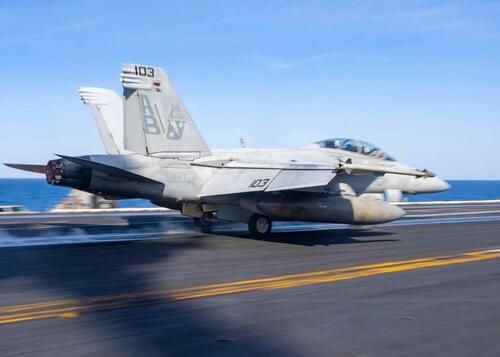 US Navy image
US Navy image
The first Super Hornet reportedly fell overboard late last month while the Truma took a hard turn amid inbound Houthi fire, in a strange incident which could just be a Pentagon cover story.
But as for the second incident, first reported Tuesday night (local US time), CNN writes that "It is not entirely clear what happened yet, as the investigation is ongoing, but two of the people said there was some kind of arrestment failure as the jet was trying to land on the carrier and the pilot and weapons systems officer had to eject."
"They were recovered by a rescue helicopter and are both alive, but they suffered minor injuries, one of the people said," the report continues.
Amid the apparent systems failure the aircraft went overboard. "The arrestment failed, causing the aircraft to go overboard. Both aviators safely ejected and were rescued by a helicopter assigned to Helicopter Sea Combat Squadron 11," a defense official described. "The aviators were evaluated by medical personnel and assessed to have minor injuries. No flight deck personnel were injured."
US Naval Institute News further details:
It’s unclear if the arresting wire that stops the aircraft during the carrier landing failed or if the hook on the fighter didn’t catch the wire. It’s also unclear whether the incident fouled the flight deck, interrupting flight operations. As of Tuesday evening, Truman was fully operational, the defense official said.
In total three jets have been recently lost in the Red Sea:
And in December, the missile cruiser USS Gettysburg, part of the Truman's strike group, shot down a Super Hornet in what the US military described as "an apparent case of friendly fire." Both aviators ejected safely.
The Houthis had since Red Sea hostilities were renewed in mid-March (in the wake of the Gaza ceasefire collapsing), sent drones and missiles against US warships off Yemen's coast, particularly the Truman carrier.
This week Israel has joined the US-led coalition's bombing campaign against the Houthis in Yemen. Israeli jets obliterated Sanaa International Airport, in an operation described as retaliation for the Sunday ballistic missile attack on Ben Gurion International Airport in Tel Aviv.
The timing of this second jet loss incident is interesting, given it was revealed the same day that President Donald Trump announced the US would stop strikes against the Houthis.
1/2
— Alan (@Alan39982121) April 28, 2025
The USS Harry S. Truman appears to have performed an emergency turn on April 27th to evade a large-scale Yemeni missile and drone attack. The maneuver was so severe it could have caused the loss of the Super Hornet.
If true, this indicates that: pic.twitter.com/MMIDOpcZdwThe Houthis have confirmed there will be a ceasefire in the Red Sea with the United States. The deal was mediated by Oman, and this looks like a 'mission accomplished' moment for Trump where he's ready to grasp onto a way out of the quagmire the US found itself in. Wisely, he is getting the US out, and Israel appears to be stepping up in terms of its own defense.
Mideast war correspondent Elijah Magnier has concluded, "The US intelligently stopped the bombing on Yemen due to the lack of objectives, the empty outcome and the high cost versus no gain."
-
Site: Catholic ConclaveConclave and Aggiornamento (bringing up to date- implying an openness to the world)There was a time when Councils were convened to defend the truth. But then came the time when one was convened to apologize for having defended it.This desire to reset tradition was called aggiornamento, and today there are still legion of cardinals who persevere in it. In a recent interview with COPE, for example,Catholic Conclavehttp://www.blogger.com/profile/06227218883606585321noreply@blogger.com0
-
Site: AsiaNews.itSince the collapse of the USSR, the five former Soviet republics of Central Asia have been debating whether to abandon the Cyrillic alphabet in favour of Latin script. Some argue it more closely reflects the phonetics of Turkic languages, but the issue is entangled with broader calls for 'de-Russification' in the context of the war in Ukraine. Even in Kazakhstan—where Nazarbayev launched the transition with the aim of completing it by 2031—serious doubts remain.
-
Site: RT - News
The two countries stand against neo-Nazism and militarism, the president has said
Moscow and Beijing remain staunch defenders of the historic truth and remember the countless people their countries lost during World War II, Russian President Vladimir Putin has said during talks with his Chinese counterpart Xi Jinping.
Xi is among the more than two dozen world leaders who are expected to attend the events in Moscow commemorating the 80th anniversary of the Soviet victory over Nazi Germany. The Chinese president is also poised to hold negotiations with Russian officials.
During a meeting on Thursday, Putin thanked his “dear friend” Xi for the visit and for joining him in celebrating a “sacred holiday for Russia.” “The sacrifices that both our nations made should never be forgotten. The Soviet Union gave 27 million lives, laid them on the altar of the Fatherland and on the altar of Victory. And 37 million lives were lost in China’s war for its freedom and independence. Under the leadership of the Communist Party, this victory was achieved,” he said.
Putin highlighted the significance of the triumph over fascism, adding that Russia and China “defend historical truth and the memory of the war and fight against current manifestations of neo-Nazism and militarism.”
The Russian leader also thanked Xi for inviting him to his country’s celebrations of its victory over Imperial Japan in WWII. “I will be glad to come back to friendly China on an official visit,” he said.
In echoing remarks, Xi emphasized shared historical memory and the strategic alignment between Beijing and Moscow. “The Chinese and Russian peoples, at the cost of heavy losses, achieved a great victory” and made an “indelible historic contribution to global peace and the progress of humanity,” he noted.
READ MORE: Kremlin aide reveals which world leaders to attend Victory Day parade
Russia and China have long enjoyed close ties, with the two countries describing their relations as a “no limits” partnership where there are “no forbidden zones.” Beijing has also consistently refused to support Western sanctions against Moscow over the Ukraine conflict.
-
Site: AsiaNews.itToday's news: New missile tests from Pyongyang. According to a study published inThe Lancet, at least 30% of girls (and 13% of boys) in India are victims of sexual abuse before the age of 18;Vietnamese environmentalist back on trial for writing "down with communism"; Tehran welcomes the end of US strikes against the Houthis;Riyadh ready to sign a deal with the United States on mineral exploitation.
-
Site: Zero HedgeDigital Euro: ECB Launches Charm OffensiveTyler Durden Thu, 05/08/2025 - 03:30
Submitted by Thomas Kolbe,
The European Central Bank (ECB) is pushing ahead with the “Digital Euro” project. On a new interaction platform, it is seeking dialogue with banks, startups, fintechs, and retailers. What is being sold as an open discourse is, in truth, calculated camouflage.
While the economic policy debate has shifted to the trade conflict with the US, things have gone quiet around the digital euro (CBDC). Yet, the ECB recently launched an online interaction platform where merchants and payment service providers can express their opinions about the new payment system. About 70 pre-selected market participants are to test the “ecosystem” of the digital euro in real-world applications and identify problems. The platform enables the testing of new payment services, such as conditional payments or the integration of digital wallets in post offices. Proponents of the project aim to modernize the payment system, granting access to the financial system even to those currently excluded due to their economic situation.
However, this mainly applies to people in poorer regions of the world-here, the benefit of a digital payment infrastructure, as offered by stablecoins (usually denominated in US dollars), is obvious. The question is whether we should consider something like this for the eurozone. Does the Chinese model of the digital yuan really align with our values, which should balance utility, efficiency, security, and individual sovereignty?
What is the Digital Euro?
The digital euro would be a small revolution, leading to a fully centralized form of central bank money. In tokenized form, it could be technically programmed and controlled-each monetary unit could be assigned conditions, each transaction centrally managed. The ECB would then be the sole issuer and operator of central wallets and the entire account infrastructure.
This raises questions about the future of commercial banks. At best, they could only function as distribution channels-their traditional role as intermediaries in payment transactions would effectively disappear. Lending would then fall into the hands of a largely autonomous central entity, which, needless to say, would be synchronized with the European Union’s objectives. According to its own statements, the ECB aims to develop the digital euro as a “secure, free-of-charge, and privacy-friendly means of payment” that, as is claimed in Frankfurt, is only intended to supplement the use of cash.
Such assurances from the ECB are nothing new, and so the launch of the interaction platform should be interpreted as a media charm offensive-or better: as a kind of transparency simulation that distracts from the real problems of this technology. Participants are pre-selected service providers whose expertise is indispensable for system design and procedural processes. Direct attacks on the monetary sovereignty of individuals or the separation of state and monetary system are not addressed on the platform. A public vote on the future of cash in the eurozone seems more unlikely than ever.
The Current State
Since November 2023, the European Central Bank has been in a two-year preparatory phase. By October or November of this year, technical foundations, data protection requirements, and initial tests are to be completed. The recently launched interaction platform, where citizens, merchants, and payment service providers can participate, is part of this process. Technically, the ECB is clearly oriented towards existing stablecoin models, where transactions are fast, secure, and free of charge. ECB President Christine Lagarde had already suggested in March that the digital euro could be introduced as early as October 2025.
But as so often with large-scale EU projects, this timeline seems overambitious and born out of haste. The challenge lies not only in technical complexity-billions of transactions are processed daily via existing systems-but also in the sensitive interplay between the central bank, commercial banks, retailers, and consumers. The overhaul is like trying to move a monolith by hand: massive, sluggish, risky.
Furthermore, the security architecture of the digital euro remains largely in the dark. Given the real threat of targeted attacks from the international hacker scene, this reticence is remarkable-real dangers, as well as fundamental systemic criticism, are ignored.
The Leviathan-Thoughts on the Background of CBDC
The digital euro is not a neutral means of payment. It is a tool of power. The ECB is no longer positioning itself merely as a central bank but as the central technological infrastructure operator for payments in Europe. For the first time, it would have direct access to the entire monetary infrastructure of the eurozone-from payment flows to account management and even to the potential control of individual monetary units. The digital euro would give the ECB not only more insight into financial activity but also far-reaching intervention and control possibilities over the financial system-with significant political and social implications.
As a largely autonomous entity, the European Central Bank has evaded democratic control since its inception. Even during the last sovereign debt crisis 15 years ago, it managed to massively expand its real-world powers by buying up government bonds on a large scale and thus effectively beginning to monetize government debt. The planned introduction of a digital euro would further cement this immediate power-with potentially profound consequences for the balance between monetary sovereignty, fiscal responsibility, and democratic legitimacy.
Why the Rush?
Against this backdrop, a central question arises: Why is the ECB pushing for the introduction of a digital euro right now? The eurozone has been stuck in a structural economic and debt crisis for some time. Germany’s economy, traditionally the EU’s anchor of stability, is in its third year of a persistent recession. At the same time, many southern European countries have long since lost control over their national debt.
Amid this fragile situation, the ECB is increasing the pressure to implement digital central bank money-a step that is not only technocratically motivated but also aims to deeply reshape the architecture of the European financial system. France, with a national debt of 120%, and Italy, with 140%, will not be able to escape the debt spiral without massive monetary interventions-the ECB is firmly planned as the “lender of last resort” in the capitals of the eurozone. Massive credit injections and yield curve control seem to be the only way out of this dilemma. A sovereign default is not an option, as it would mean the end of the entire eurozone.
The Greek crisis is a reminder. However, the mountain of debt in the eurozone has continued to rise to 95%. Bringing it under control in the event of a debt crisis would be much more complicated. The necessary expansion of the credit base to rescue over-indebted states would be so massive that investors would question the stability of the currency. In such a scenario, the digital euro would not be a neutral means of payment but a tool for market closure-with programmable transactions that could nip any capital flight in the bud.
The digital euro thus mutates into an electronic bolt: the ECB raises the drawbridges of the EU fortress to prevent a flight from the system and thus the collapse of the euro.
Consequences and Outlook
What is obviously underestimated in the Frankfurt ECB Tower is the speed at which mobile capital moves today. It is to be expected that the already beginning capital flight from the eurozone will accelerate dramatically-precisely at the moment when rumors spread in European financial centers that the ECB wants to close the gates with the help of a digital euro.
Given the political movement in the United States against CBDCs and the clear rejection of this technology by the Federal Reserve, there is a danger that Europe, especially the eurozone, will isolate itself through the ECB’s initiative. Unlike the United States, which is currently pursuing deregulation and free-market policies, the euro CBDC appears as a digital panopticon: a central authority that monitors everything, controls everything, and reserves the right to intervene at its discretion. An opaque monster that directly threatens the sovereignty of the citizen.
With the digital euro, the ECB is not only planning the creation of a new means of payment. We are witnessing an attempt to radically change the way we handle money.
What is being touted as a convenient, cashless payment option could turn out to be a Trojan horse for deep control of the financial system and the individual citizen. Unfortunately, the new interaction platform does not offer the opportunity to discuss these thoughts in detail.
-
Site: RT - News
Washington wants to look for other ways to end the conflict besides Ukraine’s idea for a 30-day ceasefire, the vice president has said
Washington wants to move away from the “obsession” with a 30-day ceasefire proposed by Ukraine, US Vice President J.D. Vance has said. The US is more interested in shaping a durable peace agreement with Moscow, he told a Munich Leaders Meeting on Wednesday.
Ukraine had floated a one-month ceasefire as a counter to Russia’s 72-hour truce proposal to mark the 80th anniversary of the Soviet victory over Nazi Germany.
However, Moscow has rejected Kiev’s plan, arguing that Ukrainian troops, which have been on the backfoot for months, would use it to regroup and strengthen their military posture.
Vance stressed that the US remains interested in a “long-term settlement” of the conflict rather than a short-term one. “We've tried to move beyond the obsession with the 30-day ceasefire and more on the what would the long-term settlement look like? And we've tried to consistently advance the ball,” the vice president said.
Read more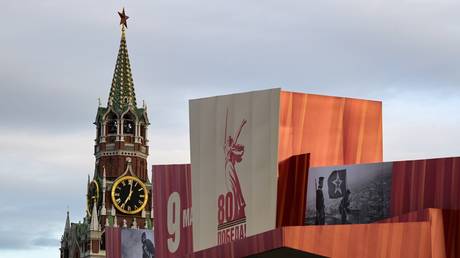 Russia’s 72-hour ‘Victory Day’ truce begins
Russia’s 72-hour ‘Victory Day’ truce begins
Vance also noted that the US has deemed Moscow’s initial negotiation proposals as excessive. “Certainly, the first peace offer that the Russians put on the table, our reaction to it was you’re asking for too much,” he said. “But this is how negotiations unfold.”
Vance added that US President Donald Trump is prepared to abandon negotiations if there is no progress, urging Moscow and Kiev to engage in diplomacy. “We would like both the Russians and the Ukrainians to actually agree on some basic guidelines for sitting down and talking to one another.”
Russia has repeatedly said it is open to talks with Kiev but noted that Ukraine has low credibility, especially when it comes to honoring ceasefire commitments. Moscow’s Foreign Ministry spokeswoman Maria Zakharova has accused Ukraine of sabotaging earlier efforts on this front, including a US-brokered 30-day moratorium on strikes on energy infrastructure and a Moscow-backed Easter truce.
In light of this, she noted that Russia would view Ukraine’s conduct during the 72-hour Victory Day ceasefire, which went into effect on Thursday, as a test of good faith. Moscow earlier described the initiative as a humanitarian gesture and a move to pave the way for direct peace talks with Ukraine without preconditions.
Meanwhile, Trump appeared to support the three-day ceasefire, noting that it “doesn't sound like much, but it's a lot, if you know where we started from.”
-
Site: Mises InstituteOh, I know, you aren’t really against free trade per se. You just demand a “level playing field.” Demanding a level playing field for international trade is a complete waste of time.
-
Site: Zero HedgeVon der Leyen Calls On EU To Hasten Ukrainian Entry As Blow To PutinTyler Durden Thu, 05/08/2025 - 02:45
European Commission President Ursula von der Leyen is calling for the fast-tracking of EU accession talks for Ukraine, though we can imagine quietly behind the scenes other European officials aren't looking forward to the day that one of the world's most corrupt countries joins the bloc.
Speaking at a Europe Day event on Wednesday, von der Leyen urged for the process to start this year, in 2025, in order to "help Ukraine stand strong" and "defy Putin’s intimidations" - according to a readout.
"Today, I would like to focus on how we can do so, and on three priorities for our action," she said. "First, support Ukraine’s defense. Second, complete the phase-out of Russian fossil fuels. And third, accelerate Ukraine’s accession path to our Union."
She then emphasized that Brussels is "working hard with Ukraine to open the first cluster of accession talks, and to open all clusters in 2025."
The Kremlin last year said that it is open to Ukraine joining the EU, but stressed that the question of joining NATO remains an impossibility, and that Moscow will never allow it.
Still, at around same time the EU question was raised, Foreign Minister Sergey Lavrov had asserted that the EU itself, which is supposed to be a purely economic and politically-linked bloc, is "becoming militarized at a record pace."
Meanwhile, the European Union has of late seemed much more open about its willingness to sabotage Trump efforts toward achieving peace in Ukraine.
The EU's top diplomat Kaja Kallas last week told the Financial Times in an interview that the bloc will not recognize Russia's annexation of Crimea under any circumstances. Really, this should be the most obvious and 'easiest' concession to make, but alas Brussels is saying no!
The White House is seeking to pressure the Zelensky government to get to the negotiating table fast, and the quickest and easiest concession would be expected to center on letting go of Crimea, which Moscow declared part of the Russian Federation after a 2014 popular referendum.
"I can’t see that we are accepting these kind of things. But we can’t speak for America, of course, and what they will do," Kallas had said. "On the European side, we have said this over and over again... Crimea is Ukraine."
"There are tools in the Americans’ hands that they can use to put the pressure on Russia to really stop this war," Kallas continued. "President Trump has said that he wants the killing to stop. He should put the pressure on the one who is doing the killing."
This has basically been the Ukrainian government's position all along as well. For this reason, she said Brussels and other European capitals are still focused on "working with the Americans and trying to convince them why the outcome of this war is also in their interest, that Russia doesn’t really get everything that it wants." But again, Crimea should be the easiest issue.
-
Site: Catholic Herald
Under a darkening evening sky with seagulls and flashing drones swooping over the crowd crammed into St Peter’s Square, the black smoke finally came at 9 p.m. from the Sistine Chapel. The crowd roared but the dark soot-like colour came as no surprise. The starting gun had gone off for the race to win the Crown of Peter.
The crowd were not overjoyed by the long wait. The Roman sky has become so dark that it was difficult to see the colour of the crucial plume emitting from the chapel’s chimney. The Italian media are speculating that Raniero Cantalamessa, the 90-year-old Preacher to the Papal Household, went on way too long in his “spiritual reflection”. For 45 minutes, so Corriere reported.
Either way, the slow clapping began around 8 p.m. That’s when other important choices are made in the Eternal City over dinner. By 9 p.m. it had begun to feel like that famous Test Match won in the Karachi darkness by batsmen Nasser Hussain and Graham Thorpe in 2000.
Part of the problem, I am hearing, is that with so many new cardinals, not familiar with the arcane rituals and procedures of the conclave, not all cardinals know what they are doing.
Earlier in the day, just after 5 p.m., the 133 cardinals – average age of 70 – had lined up in the Sistine Chapel, placed their right hand on the sacred book standing on a gilt table in the middle of the Sistine Chapel, read out their name and gave a personal oath in Latin before the voting got underway. Several – especially those from the Americas and from Africa – clearly struggled with their spoken Latin.
Sequestered with the world’s media inside the John Paul II Hall, next to St Peter’s Basilica, it was difficult not to be moved by the theatrical spectacle of the most magnificent of roll calls – lasting around 45 minutes – which kicked off the conclave, not to mention the display of quite a selection of cardinal’s gold rings.
The names went on…and on. No wonder Pope John Paul had limited the number of voting cardinals to 120. And then, at exactly 5.46 p.m., two Swiss guards stood to attention and the giant doors to the Sistine Chapel were shut with two loud bangs. The doors were now locked, the cardinals sequestered from the world.
Then the crowds in St Peter’s began to wait, and wait for the Holy Sprit to speak in a bellow of smoke. Milling around in the crowds, one almost felt sorry for the papal souvenir shops in Vatican City who had put up rather desperate signs in Italian and English to the effect of “last chance to buy Papa Francis merch”.
The moment the next pope walks on to the balcony, buttons will be pressed in Italian factories mass producing the new pope’s face on T-shirts, mugs and postcards. It’s worth recalling that until about 100 years ago nobody actually knew what the pope looked like, and few Catholics even knew his name, other than that he was an Italian; back then the Vatican seemed a very distant kingdom. Not a place that you ever expected to visit. The pope was more a holy office than a person.
This aloofness gave a sense of mystery to the Holy Father before the age of TV cameras, social media and jet hopping super-popes that began with John Paul II. One hopes that whoever is elected pope does a little less travelling by chartered papal jet and makes the focus of his pontificate saving souls and uniting the Church rather than politicising the papacy. Maybe we need a little bit of dullness right now.
The first day of the conclave began at 10 a.m. with the sacred Mass in St Peter’s called Per L’Elezione Del Romano Pontefice (“For the Election of the Roman Pontiff”). The Order of Service was a glossy booklet of 69 pages decorated with an image of the dove of peace, flanked by winged cherubic putti holding up the gospels in Latin. The extraordinary sight of all the cardinals, dressed in scarlet, “processing” – shuffling, or in some cases, staggering through the central aisle – was likened by Catholic Herald artist Adam Dant, there in attendance with me, to “watching horses on parade before a prize race”.
There was little choreography, based on age or seniority, with the Cardinals pottering along unaccompanied at their own pace. They gave no indication of the voting pacts and blocks going on in the background and surely exercised when the first votes were cast on the afternoon of 7 May. “You could have reached out and touched them,” added Dant, who also noted that the Italian next to him was doing his on-line check-in for a London flight on his phone (he obviously didn’t think the conclave wold take long, though others think it most certainly could).
Looking at so many of them shuffling in, some almost needing support, one can see why age could turn out to be a defining factor of this papal election. Back in 2013, the choice of Cardinal Bergoglio – later Pope Francis – took most Vatican journalists by surprise as he was considered “a bit old” at 76, just four years away from the voting cut-off age of 80. His age, indeed, was one of the factors that caught the conservative camp off-guard.
With the last few day’s of campaigning in the Vatican turning into an at times unholy war of dirty tricks and smears on both sides, it may be that the cardinals will turn – as they did in 1978 by appointing the 58-year-old John Paul II – to a pope from a different generation. The subtext of all the recent attacks and cardinal watchdog leaks is that Luis Tagle and Pietro Parolin, in particular, cannot be trusted with the Crown of Peter as they are not “safe”, being too closely associated with a litany of financial and sexual cover ups.
If there is going to be a big surprise on the St Peter’s balcony – the window is already shrouded with deep crimson drapes – it may be to do with the conclave wanting a younger pope not besmirched by the sins of the father. A younger pope could be seen as a chance to take the Church into a new chapter, untainted by the sex abuse scandals that have rocked the Church to its very foundations in the last 20 years from the end of the St John Paul II years, through the Benedict XVI and Francis I era.
Almost all the elderly cardinals – especially the generation of Parolin and Erdo – will almost certainly have had their long nights of the soul when it comes to having known something about a clerical sex abuse cover up, or financial scandal, during their time as an archbishop or bishop, and the last thing the Church needs now is for some investigative journalist to expose the next pope as having been mired in some past misdeed, or cover up, even if they were not to blame.Whilst Vaticanastas usually take the view that the conclave doesn’t like to vote for younger popes as they may be around for decades – and thereby do more damage to the Church if their pontificate goes astray – don’t dismiss the idea of the Latin Patriarch of Jerusalem, Cardinal Pierbattista Pizzaballa, who is only 60. He is also Italian which might help since there is a mood here that it is time for the Crown of Peter to return home.
I am a believer in omens and divine providence. Just as I was discussing this theory supporting Pizzaballa over cannelloni and fried squid in the trattoria Al Passetto di Borgo, the famed “canteen of the cardinals” (Pope Benedict was a regular), our waiter whispered in our ears that seated at the table behind were the two private secretaries of the Latin Patriarch himself.
Photo: Nuns react at St Peter’s Square as black smoke rises from the chimney of the Sistine Chapel signalling that cardinals failed to elect a new pope in the first ballot of their secret conclave at the Vatican, 7 May 2025. (Photo by DIMITAR DILKOFF/AFP via Getty Images.)
William Cash is former Editor of the Catholic Herald and a journalist and writer who contributes to the Daily Telegraph, The Spectator, and others.

The post Conclave notebook: a ringside seat for first day of smoke first appeared on Catholic Herald.
The post Conclave notebook: a ringside seat for first day of smoke appeared first on Catholic Herald.
-
Site: Zero HedgeGermany's New Chancellor Slams US Meddling, Defends Crackdown On 'Far-Right'Tyler Durden Thu, 05/08/2025 - 02:00
After the Trump administration condemned Germany’s slide into tyranny and anti-democratic actions against the Alternative for Germany (AfD), the new German government under Friedrich Merz is now openly criticizing the U.S. for pointing out these tyrannical methods.
Realizing that there is serious potential for conflict between Washington and Berlin, Merz says he will speak to the U.S. government.
Merz criticized the voices from parts of the U.S. government that supported the AfD during the federal election campaign and recently criticized the party’s classification as right-wing extremist by the Federal Office for the Protection of the Constitution.
The current main point of contention is the powerful domestic spy agency, the Federal Office for the Protection of the Constitution (BfV) and its decision to classify the Alternative for Germany (AfD) as a “confirmed right-wing extremist” party. Merz said the U.S.’s comments were “absurd observations of the Federal Republic of Germany,” and that “I’ve actually always had the feeling that America is able to distinguish very clearly between extremist parties and parties of the political center.”
The BfV operates with modern Stasi-like powers but wields a far greater technological arsenal. Under the new designation, the BfV can now legally surveil all AfD members without a warrant, including reading their emails and chats. It can also flood the AfD party with informants and take action against civil servants who are members of the party.
The fact that the AfD is the largest opposition party in the country and that there are now efforts underway to ban the party is causing serious alarm in the United States, which is calling the German government’s path forward authoritarian and undemocratic. Most notably, Secretary of State Marco Rubio called it “tyranny in disguise.”
Germany just gave its spy agency new powers to surveil the opposition. That’s not democracy—it’s tyranny in disguise.
— Secretary Marco Rubio (@SecRubio) May 2, 2025
What is truly extremist is not the popular AfD—which took second in the recent election—but rather the establishment’s deadly open border immigration policies…Perhaps the best analogy would be if the U.S. government suddenly declared the Democratic Party a “confirmed extremist” party because it promotes open borders, and under Biden, effectively brought millions of more illegal migrants into the country. Then, a Republican-appointed spy chief surveilled all members of the Democratic Party without a warrant, was able to send informants into the party, and could fire teachers, judges, and police officers who were members of the party.
If such a scenario occurred, the liberal EU and mainstream press would be the first ones to scream about “tyranny” and a new “authoritarian” reality in the United States, with Germany at the top of the list.
Merz, on the other hand, seems dismissive of the U.S. critiques. He said he will speak with Donald Trump and establish contacts with the White House, but Merz may be in store for a chilly reception.
In regard to Trump, Merz said: “We don’t know each other personally yet.”
However, he said at the end of June, he will meet with Trump at the NATO summit in The Hague and “perhaps even sooner.” He said they “talk openly with each other.”
“As Europeans, we have something to offer; together we are even bigger than the United States of America,” said Merz.
“We can do something, we are united, largely anyway. That will be my message to the American government.”
“I did not interfere in the American election campaign and did not take sides unilaterally for one party or the other,” said Merz.
However, democratic backsliding in Germany is a grave concern for the entire world, and there are fears that a ban of the AfD could come sooner than later. In such a scenario, millions of voters would be denied their democratic rights.
Not everyone in the CDU, or its sister party, the Christian Socialist (CSU), is on the same page though.
CSU leader Markus Söder is warning against an AfD ban, saying it should only serve as a “wake-up call” to change government policies. He said he is not sure the BfV report is sufficient for a ban.
-
Site: The Unz ReviewIn February, President Trump said that tariffs would generate so much income that Americans would no longer need to pay income taxes. The latest plan, according to U.S. Commerce Secretary Howard Lutnick, is to abolish income taxes for people who earn less than $150,000 yearly. That move would affect roughly 75% of workers, according to...
-
Site: Restore-DC-Catholicism
-
Site: The Unz ReviewQuestion 1---On Tuesday, President Trump said that the US will stop bombing Yemen because the Houthis said they would “not be blowing up ships anymore.” Trump added that the Houthis "capitulated" and "don’t want to fight anymore”. Is Trump telling the truth; did the Houthis 'give up'? Aisha Jumaan--- Based on the attached statement from...
-
Site: The Unz ReviewWhen liberals destroyed religion, they destroyed morality. With the demise of morality went integrity and a person’s word. Today Western societies are overwhelmed by crime. Sexual morality is long gone. Young women compete for attention according to which woman can copulate with the most men in a 24-hour time period. One contestant says her father...
-
Site: The Unz ReviewMay 8, 2025 marks the 80th anniversary of Germany’s unconditional surrender to the Allies and the Soviet Union. Many modern-day Germans are so deluded and so brainwashed that they actually celebrate their nation’s catastrophic defeat and ruin. The leadership of Adolf Hitler was, of course, ultimately a disastrous failure. But, as argued in “Denouncing Hitler...
-
Site: The Unz ReviewThis video is available on Rumble, Bitchute, Odysee, Telegram, and X. Washington State is run by some of the craziest white people in the country. In 2019, the legislature voted to overturn a ballot initiative and bring back anti-white race preferences. Critical Race Theory is taught in public K-12 schools, thanks to a state law...
-
Site: The Unz ReviewOn May 17th activists connected to the youth wings of Flanders’ Vlaams Belang, Portugal’s Chega, Alternativ Für Deutschland, and other New Right populist groups will be hosting the Remigration Summit in Milan. The event is being marketed as an attempt to de-demonize discussion on European immigration restriction and reframe the conversation around mass deportations in...
-
Site: non veni pacem

-
Site: Zero HedgeHow An India-Pakistan War Could Derail Central Asia's FutureTyler Durden Wed, 05/07/2025 - 23:25
Authored by James Durso via OilPrice.com,
-
A war between India and Pakistan would significantly destabilize Central Asia, disrupting trade routes, delaying infrastructure projects, and increasing regional militancy.
-
China, Russia, and the U.S. may intensify involvement in Central Asia, leveraging the conflict to protect or expand their influence.
-
Potential nuclear fallout, refugee flows, and the breakdown of regional cooperation could severely impact Central Asia’s economic development, security, and food systems.
If India and Pakistan spiral into war, there will be consequences for Central Asia.
A war between Pakistan and India would likely have significant ripple effects on Central Asia, given the region's proximity to Afghanistan and flourishing economic ties across the region. The conflict could disrupt trade and energy routes, increase militancy, and draw in major powers like China, Russia, and the U.S., potentially straining Central Asian stability.
Intervention by external powers: The Central Asian republics (Kazakhstan, Uzbekistan, Turkmenistan, the Kyrgyz Republic, and Tajikistan) are already arenas for competition among outside powers. A Pakistan-India conflict could draw these powers into the region more aggressively to secure their interests, though Russia is busy in Ukraine, Turkey is busy in Syria, and U.S. forces are fighting in the Middle East, and Washington is ready to confront China.
China is an ally of Pakistan and sponsor of the $65 billion China-Pakistan Economic Corridor (CPEC). China might deepen its presence in Central Asia to secure trade routes and counterbalance India’s regional influence. This could accelerate Chinese investments in infrastructure and energy projects that will increase trade with the region that totaled $89 billion in 2023, up 27% from 2022, $60 billion of which was Chinese exports.
And China may make further inroads into the Central Asia arms market given Moscow’s need to dedicate all its resources to the Russia-NATO war in Ukraine. This will allow China to broaden its engagement beyond infrastructure projects into the security realm that, up to now, has been limited to anti-terrorism training and intelligence sharing in Tajikistan.
Russia is an ally of India, a buyer of Russian arms, having purchased $60 billion of Russian arms, 65 percent of its total weapons imports, over the past twenty years With its historical ties to Central Asia and shared membership in the Collective Security Treaty Organization (CSTO), Russia might leverage a conflict to reinforce the region’s border security, and increase intelligence sharing and security forces training.
And just in time, Russia has declared it will help the Taliban government fight the Afghan branch of the Islamic State, the Islamic State – Khorasan Province (IS-K).
The United States could focus on Central Asia to counter China and Russia, potentially increasing military or economic aid to Uzbekistan or Kazakhstan, the major economies in the region. Unlike the leaders of Russia or China, no American president has ever visited Central Asia but President Donald Trump could signal increased U.S. attention by visiting the region.
Afghanistan as a flashpoint. Afghanistan, bordering both Pakistan and Central Asia, would likely become a hotspot. The Afghan Taliban’s support for the Pakistani Taliban, the Tehreek-e-Taliban-e-Pakistan (TTP) could further destabilize Pakistan, presenting Islamabad with the prospect of a two-front war, though recent visits by Pakistan’s diplomats, and military and security officials seeking a “diplomat reboot” may be just in time to stanch action by the TTP.
Instability would come to Central Asia via Afghanistan in the form of refugees and energized militants, and economic stagnation in the delay of development projects like the Trans-Afghan railway, the Turkmenistan–Afghanistan–Pakistan–India (TAPI) natural gas pipeline, and the CASA-1000 renewable energy infrastructure construction project.
General disorder may spill insecurity into Tajikistan and Uzbekistan, where cross-border militancy (e.g., the Islamic Movement of Uzbekistan (IMU), which has pledged allegiance to al-Qaeda, and IS-K could surge.
And the instability will cause a slowdown in foreign direct investment that has steadily climbed as has foreign trade in goods and accession to bilateral investment treaties. The region’s economy suffered “lost decades” between the start of the Afghan civil war in 1992 and the end of the NATO occupation of Afghanistan in 2021 and has been making steady progress in connecting to the wider world economy; Turkmenistan and Uzbekistan are completing the World Trade Organization (WTO) accession process, and Kazakhstan and Tajikistan are WTO members.
And just in time for a war, the World Bank is predicting economic slowdown for Central Asia: Kyrgyzstan and Tajikistan will suffer pronounced declines, Kazakhstan’s decline will be less pronounced, and Uzbekistan’s growth rate will remain steady at 5.9%.
The U.S. may try to leverage disorder on Afghanistan’s border with Pakistan to pressure the Kabul government, but that risks empowering Al-Qaeda, IS-K, the hardline Taliban faction in Kandahar, or some combination of the three. Disorder in Pakistan’s Balochistan province, the poorest place in Pakistan, may energize the local separatists and draw in bordering Iran which faces a Baloch insurgence on its side of the border.
India’s Central Asian Ambitions. India’s efforts to access Central Asian and Afghan resources, via Iran’s Chabahar port, could be disrupted, forcing India to seek alternative routes or deepen ties with Russia and Iran, affecting regional alignments, and angering the U.S. which is trying to isolate Moscow and Tehran.
India imports uranium for its nuclear power program from Kazakhstan and Uzbekistan and an uninterrupted supply by the republics will be a sign to India they value their relationship with Delhi.
Trade Route Disruptions: Central Asia relies on connectivity projects like CPEC and the International North-South Transport Corridor (INSTC). A war could disrupt CPEC which links China’s Xinjiang province to Pakistan’s Gwadar port and passes through contested areas like Kashmir. India’s trade routes to Central Asia via Iran and Afghanistan could be jeopardized if conflict escalates or Afghanistan becomes unstable, though if Indian merchantmen are unmolested by Pakistan the impact may be minimized and they will be able to safely dock at Iranian ports.
Tightened border controls will hurt regional trade that was boosted by eased border controls that teased the possibility of a unified regional market, following the resolution of many territorial disputes, a process that began in earnest after the 2016 election of Uzbekistan’s president, Shavkat Mirziyoyev.
The Central Asia republics trade with India and Pakistan and will be reluctant to be drawn into one side’s economic warfare on the other. Kazakhstan, Uzbekistan, and Turkmenistan, the three largest economies in the region, all import packaged medicaments and vaccines from India and mostly food products from Pakistan, and may find it easier to replace the lower-valued agriculture products than disrupting their medical supply chain.
Pakistan and Kazakhstan recently inked a transit trade agreement that would see goods shipped from Central Asia through the Pakistani ports of Karachi, Bin Qasim, and Gwadar, and the start of direct flights between the countries. An India-Pakistan war will bring in the insurance companies who may cancel coverage to aircraft, trucks, and their cargoes, delaying the benefits of the deal.
Spillover of Militancy: A Pakistan-India war, especially if centered on Kashmir, could embolden extremist groups like Jaish-e-Mohammed or Lashkar-e-Taiba, which have historical ties to Afghan and Pakistani militants.
This could inspire increased terrorist activity in Tajikistan and Uzbekistan, where groups like the IMU and IS-K could exploit regional conflict for recruitment and radicalization.
Nuclear Risks: Both nations possess nuclear arsenals, less than 200 weapons each. Even a limited nuclear exchange could cause dire environmental and climatic effects, disrupting Central Asian agriculture and food security, and pretty much eliminating agriculture exports as customers fret about “contamination,” despite the prevailing westerly winds. In Uzbekistan, agriculture contributes about 25% to the Gross Domestic Product and employs about a quarter of the workforce, so the economic (and political) impact would be profound.
Conflict in Pakistan or Afghanistan could drive refugees into Central Asia, particularly Tajikistan, straining resources and sparking ethnic tensions, and destabilizing resource-strapped governments.
India and Pakistan are members of the Shanghai Cooperation Organization (SCO), as are several Central Asian states, and China and Russia. A war could paralyze SCO initiatives, hindering regional security and economic cooperation. Tensions might also exacerbate India-China rivalries within the SCO, affecting Central Asia’s balancing act.
Specific Impacts on Central Asian States
Tajikistan shares a porous border with Afghanistan, making it vulnerable to militancy and refugee inflows. India’s military training programs with Tajikistan could be disrupted, and its newly-refurbished (by India) Ayni Airbase base may worry Pakistan.) As a regional leader, Uzbekistan might seek to strengthen ties with Russia and China to counter instability, however, its trade with South Asia could suffer. Neutral but energy-dependent, Turkmenistan could benefit from Chinese energy demand. As the major Central Asia economy, Kazakhstan might leverage its SCO and Eurasian Economic Union ties to mitigate disruptions but could face energy market volatility. Kyrgyzstan is economically fragile and be hit hard by trade disruptions increasing reliance on China or Russia.
Long-Term Implications
Regional Polarization: Central Asia could become more divided, with some states aligning with China (e.g., Turkmenistan) and others with Russia or the West (e.g., Kazakhstan, Uzbekistan), hindering regional unity, which may be in the interests of Washington, Beijing, Brussels, or Moscow.
Securitization: Fear of spillover could lead Central Asian states to increase security spending, diverting resources from economic development. More than half of Central Asia’s population is under 30 years of age and they have high expectations that governments are trying to satisfy by increasing educational and economic opportunity, and diversifying the economies away from agriculture and natural resource extraction, and towards technology, services, and tourism. And more security may come at the expense of civil rights.
Environmental Fallout: A nuclear conflict, even limited, could cause global climate disruptions, devastating Central Asia’s agriculture-dependent economies.
Conclusion
India has been active in Central Asia with its Connect Central Asia Policy, which aims to enhance trade, connectivity, and diplomatic engagement, and hinges on India’s development of Chabahar port in Iran, though the Trump administration rescinded the sanctions waiver on Chabahar. Washington’s fixation on Iran, specifically ruining its economy to press it for a favorable nuclear deal, may see India and Central Asia as collateral damage.
The republics import higher value goods from India (Packaged Medicaments) than they do from Pakistan (food products), and sell uranium – a strategic good – to India. India has a larger market than Pakistan and is a provider of technology products that Pakistan cannot match, and the republics’ future is with India, though they have no reason to antagonize Islamabad.
A Pakistan-India war would destabilize Central Asia by disrupting trade, fueling militancy, and intensifying great power rivalries. The region’s proximity to Afghanistan and reliance on connectivity projects make it particularly vulnerable. Central Asian states would face economic strain, security threats, and pressure to align with external powers, potentially fracturing regional cooperation. The nuclear risk underscores the catastrophic potential, with global climatic effects threatening Central Asia’s food security and economic stability. To mitigate these risks, Central Asian states might pursue neutrality, strengthen SCO ties, or seek mediation roles, but their limited clout may constrain effective responses.
-
-
Site: Zero HedgeWorld's Largest Jewelry Brand Says Reshoring US Production "Simply Won't Work"Tyler Durden Wed, 05/07/2025 - 23:00
Pandora Jewelry CEO Alexander Lacik spoke with Bloomberg TV's Anna Edwards on Wednesday about the potential for re-shoring production from Asia to the U.S. in response to President Trump's trade war. But the head of the world's largest jewelry company offered a blunt assessment: Pandora has no plans to overhaul its supply chain.
Edwards asked Lacik: "So, a third of Pandora's business comes from the U.S., which means you're quite exposed to tariffs since you produce 95% of your jewelry in Thailand. You have plans to open a site in Vietnam, but there's a 46% tariff on products coming from Vietnam into the U.S. So, Alexander, does this have you looking at other production locations?"
Lacik responded, "If I wanted to build another plant somewhere, it would take roughly three years to get something up and running. You would actually need to go to places where there is a tradition of crafting. I have almost 15,000 craftspeople working for Pandora in Thailand at the moment. Those craftspeople have many years of tradition in doing crafted jewelry."
Here's one of Pandora's Thailand factories...
"So it's not so easy, just - it's not like moving a machine from one place to another. So, first of all, finding the skilled people who can do the jewelry for us would be the first protocol," Lacik said,
He was very blunt: "So if you look at labor costs, if I were to consider going to the US, in terms of economics, that equation wouldn't work for us."
The takeaway from the world's largest jewelry company—which designs, manufactures, and markets hand-finished pieces from Southeast Asia—is that it has no plans to abandon its ultra-low-cost manufacturing hubs. That means Pandora will either absorb the tariffs or pass the added costs on to consumers.
"It's not like moving a machine from one place to another"
— Bloomberg (@business) May 7, 2025
Pandora CEO Alexander Lacik tells @annaedwardsnews the jewelry company is not looking to build production facilities in the US to mitigate its exposure to Trump's tariffs https://t.co/avWsTlJs4V pic.twitter.com/K1PtRDqsdAFor what it's worth, one could argue that Americans can live without Pandora jewelry. Instead, consider buying gold and silver coins or bars—real stores of value.
-
Site: Zero HedgeFBI Mishandled Investigating Congressional Baseball Shooting, House Committee FindsTyler Durden Wed, 05/07/2025 - 22:35
Authored by Jackson Richman via The Epoch Times,
A House Intelligence Committee report released on May 6 says that the FBI mishandled its investigation of the 2017 shooting at a GOP practice one day before the annual Congressional Baseball Game—including not calling the incident domestic terrorism and not interviewing key figures.
The committee’s chairman, Rick Crawford (R-Ark.), accused the FBI of holding up the report.
“There’s no reasonable or acceptable explanation for why the FBI stonewalled the committee for so long,” he said during a press conference.
“In fact, it’s taken so long to get this case file, many of those members at the field on that fateful day are no longer in Congress.”
The report found that the FBI did not thoroughly interview victims and eyewitnesses to the shooting, where House Majority Leader Steve Scalise (R-La.) and four others were shot.
Scalise was shot in the hip and seriously wounded, requiring several surgeries and a lengthy recovery.
Former Rep. Mo Brooks (R-Ala.) was not interviewed despite being at the scene during the shooting.
The shooter, James Hodgkinson, was shot and killed by Capitol Police, who were already on the scene due to Scalise’s presence as he was a member of House GOP leadership and therefore afforded a security detail.
The report also found that the bureau did not come up with a timeline of events surrounding the shooting.
The report attempted to dispute the FBI’s claim that the shooting was not connected to domestic terrorism.
In a press release following the shooting, the FBI said it “does not believe there is a nexus to terrorism.”
The Intelligence Committee report criticized the press release, saying it failed to include information that would have contradicted what the report called the FBI’s “suicide by cop” narrative.
“To commit suicide by cop, the perpetrator needs to demonstrate hostile intent in the presence of police. In this case, there were no observable police officers present,” the report said, noting that the officers were dressed in plain clothes.
The report said that the FBI’s “conclusions failed to follow the facts, as it reached an unsupported conclusion without completing even the most basic of investigative activities.”
The report said that while the FBI cited that Hodgkinson’s brother believed that the aim of the shooting was for Hodgkinson to die by suicide by cop, this was merely the brother’s opinion and not based on any communications.
Scalise was made aware of the report by the committee, according to Crawford, who declined to elaborate as he did not want to speak on Scalise’s behalf.
In a statement to The Epoch Times, the FBI said it “is committed to working quickly and transparently with Capitol Hill to ensure the American people receive the full truth they deserve.”
“We have diligently delivered all requested documents and will continue to cooperate fully with Congress to uphold transparency and accountability,” the bureau said.
-
Site: 4Christum
Pedophile Theodore McCarrick with one of his sexual abuse victims, minor James Grein
When the world’s cardinals met in Rome last Monday for the first of their crucial pre-conclave discussions, they raised ‘the issue of clerical abuse’, according to a Vatican spokesman.The cardinals are forbidden to reveal anything that was said.
But behind closed doors, the preparations for the conclave – which starts on Wednesday – are already mired in scandal.
Aside from doubts about the true age of Philippe Ouedraogo, a cardinal from Burkina Faso whom some claim is 80, meaning he’s too old to vote, and concerns about the presence of the Peruvian cardinal Juan Luis Cipriani, who faces sexual abuse allegations (which he denies), several cardinals have torn into the legacy of the late Pope Francis.
‘We have listened to many complaints against Francis’s papacy in these days’, one unnamed cardinal told America Magazine, a Jesuit publication.
In any case, we can be certain that Monday’s debate was haunted by a series of jaw-dropping scandals whose details are unknown to the vast majority of the 400,000 Catholics who attended Pope Francis’s funeral a week ago.
If they had known, the crowds would have been much smaller.
For the common denominator of these scandals – whose victims included 20 Slovenian nuns who claim to have been raped, Argentinian seminarians grotesquely assaulted by their bishop and a Belgian teenager subjected to incestuous assault by his uncle, a bishop – is that Francis went to bizarre lengths either to conceal or excuse these crimes.
The ‘people’s Pope’ was elected in 2013 on a promise to hold the Church accountable for clerical sex abuse.
And it’s true that he did establish new rules designed to punish bishops found guilty.
But the first Argentinian pontiff did not practise what he preached.
Continue reading at the Daily Mail
Sex Abuse Researcher Richard Sipe has died. The researcher of the Webpage BishopAccountability that points out Bergoglio´s cover-up of pedophiles as cardinal and president of the episcopal conference in Argentina
Bergoglio Accused of Sex Abuse Cover-Up in Argentina in 2002
Bergoglio approved the Argentine Leonardo Sandri who covered up pedophile Marciel Maciel as Vice Dean of the College of Cardinals
Francis Knew His Protégé Took Nude Selfies, Abused Seminarians; But Promoted Him to Top Vatican Post
Victims of homosexual predator Zanchetta say Bergoglio spits in their faces.Homosex Victim: Francis knew that Zancheta was sexually abusing us.
Dr. Janet Smith – Is Sexual Abuse Cover-Up Now a Prerequisite for Becoming Archbishop of Washington DC?

